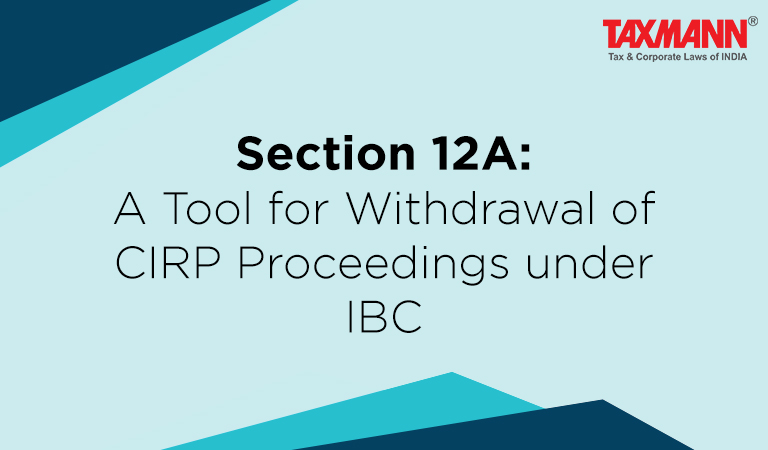Section 12A: A Tool for Withdrawal of CIRP Proceedings under IBC
- News|Blog|Insolvency and Bankruptcy Code|
- 2 Min Read
- By Taxmann
- |
- Last Updated on 22 February, 2022

Introduction
Insolvency and Bankruptcy Code, 2016 (hereinafter “IBC” or “the Code”) was enacted with the objective of providing an efficient mechanism for revival, reorganization, and resolution of distressed or bankrupt entities/persons in a time-bound manner to resolve the issues of the creditors. Within a period of just 5 years, the Code has been amended many times to make it more efficient and market-driven. One such case was the insertion of Section 12A into the Code vide IBC amendment Act of 2018 which paved the way for erstwhile management of Corporate debtor (hereinafter ‘CD’) to settle matters between the creditors and withdraw the cases under Corporate Insolvency Resolution Process(hereinafter ‘CIRP’).
Why was 12 A introduced?
Section 12A was added to the code IBC (Second Amendment) Act, 2018, w.e.f. 6-6-2018 with retrospective effect. The code before the amendment did not have any provisions for settlement of debts between the creditors and the promoters. Even the NCLT or NCLAT did possess the inherent powers to grant withdrawal of admitted application under sections 7, 9, and 10 of the Code even if the applicant, creditors and erstwhile management/promoters of CD agreed to settle the matters outside IBC1 after admission of application by Adjudicating Authority (hereinafter ‘AA’). On one hand the code was introduced to ensure timely disposal of insolvency matters but on the other it failed to recognize the way of settlement with the creditors as a viable option for resolution, which could ensure maximization of assets and timely settlement of dues between parties. Therefore, parties started approaching the Apex court for relief, and the court under Article 142 passed orders for allowing withdrawal of applications against CD under CIRP. In November, 2017 the Hon’ble Supreme Court (hereinafter ‘Apex Court’) in the case of Uttara Foods & Feeds (P.) Ltd v. Mona Pharmachem2 directed the government to incorporate a provision under the Code allowing for post-admission withdrawal, and preventing such applications to be filed before the Supreme Court.
Click Here To Read The Complete Article
Disclaimer: The content/information published on the website is only for general information of the user and shall not be construed as legal advice. While the Taxmann has exercised reasonable efforts to ensure the veracity of information/content published, Taxmann shall be under no liability in any manner whatsoever for incorrect information, if any.

Taxmann Publications has a dedicated in-house Research & Editorial Team. This team consists of a team of Chartered Accountants, Company Secretaries, and Lawyers. This team works under the guidance and supervision of editor-in-chief Mr Rakesh Bhargava.
The Research and Editorial Team is responsible for developing reliable and accurate content for the readers. The team follows the six-sigma approach to achieve the benchmark of zero error in its publications and research platforms. The team ensures that the following publication guidelines are thoroughly followed while developing the content:
- The statutory material is obtained only from the authorized and reliable sources
- All the latest developments in the judicial and legislative fields are covered
- Prepare the analytical write-ups on current, controversial, and important issues to help the readers to understand the concept and its implications
- Every content published by Taxmann is complete, accurate and lucid
- All evidence-based statements are supported with proper reference to Section, Circular No., Notification No. or citations
- The golden rules of grammar, style and consistency are thoroughly followed
- Font and size that’s easy to read and remain consistent across all imprint and digital publications are applied



 CA | CS | CMA
CA | CS | CMA
